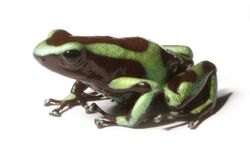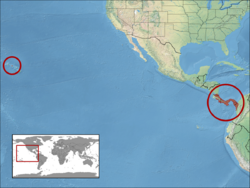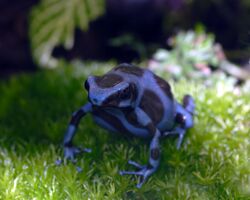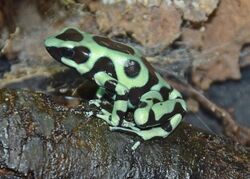Biology:Green and black poison dart frog
| Green and black poison dart frog | |
|---|---|

| |

| |
| Two D. auratus from Panama | |
| Scientific classification | |
| Domain: | Eukaryota |
| Kingdom: | Animalia |
| Phylum: | Chordata |
| Class: | Amphibia |
| Order: | Anura |
| Family: | Dendrobatidae |
| Genus: | Dendrobates |
| Species: | D. auratus
|
| Binomial name | |
| Dendrobates auratus (Girard, 1855)
| |

| |
| Range in red (Hawaiian population introduced) | |
| Synonyms | |
|
Phyllobates auratus Girard, 1855 "1854" | |
The green-and-black poison dart frog (Dendrobates auratus), also known as the green-and-black poison arrow frog and green poison frog (among others),[1][3] is a brightly-colored member of the order Anura native to southern Central America and Colombia. This species has also been introduced to Oahu, Hawaii in an effort to lower mosquito numbers.[1][3][4] It is one of the most variably colored species of poison dart frogs, after D. tinctorius, Adelphobates galactonotus and some Oophaga species. From a conservation standpoint, it is considered to be of least concern by the International Union for Conservation of Nature. Within the reptile and amphibian hobby, D. auratus remains one of the most commonly kept, and easiest-to-breed, dart frogs in captivity, as well as in zoos.[1]
Description
The green-and-black poison dart frog has the typical appearance of the members of its family; males average 0.75 in (1.9 cm) in snout–vent length, while females are slightly larger, averaging 1 in (2.5 cm) or longer.
The green-and-black poison dart frog is one of the most variable of all poison frogs in color and pattern. This variation is to some extent individual, but also depend heavily on exact location. Despite the name green-and-black poison dart frog, some variants have no green or no black; a few, like the brown and cream-white Campana variant, may have neither green nor black. However, most often, green-and-black poison dart frogs have a highly variable, spotted or banded pattern in vivid mint-green coloration, but this can also be a darker green, forest-green, lime, emerald, turquoise, or even blue, whitish or pale yellow. Mixed with this are splotches of dark or dull coloring, most often blackish, but ranging from whitish-brown and bronzy brown to dark brown and pure black. The amount of dark or dull coloring varies greatly (certain variants are entirely black, or dark with only a few small green spots or streaks) and may appear as large or small spots or blotches, or as a dappled or "splashed" pattern.[5]
Distribution
The green-and-black poison dart frog is found in humid lowland and submontane forests at altitudes of 0–1,000 m (0–3,280 ft) in southeastern Nicaragua on the Atlantic slope, eastern Costa Rica on the Atlantic slope and in the southwest on the Pacific slope, widely in Panamá, and into far northwestern Colombia in the Chocó Department.[1][3][6] An introduced population exists on Oahu, in Hawaii;[1][3][4][7] the species was intentionally introduced there, in 1932, for mosquito control. Later on, it seems to have also become established on Maui.[4]
Poison
The green-and-black poison dart frog, while not the most toxic poison dart frog, is still a highly toxic animal. The very small amount of poison the frog possesses is enough to make a human heart stop beating.[citation needed] The green-and-black poison dart frog, as with all poison dart frogs, loses its toxicity in captivity due to a change in diet. This has led some scientists to believe that the green-and-black poison frog actually takes its poison from the mites and other insects on which it feeds.[8]
Behavior
The green-and-black poison dart frog is semi-arboreal, hunting, courting, and sleeping in the trees. Like other dart frogs, they spend much time in the shallow pools of water created in the cup-like leaves of bromeliad plants. The same plants often serve as nurseries for tadpoles. As it is a tiny frog, it cannot obviously leap from branch to branch in the treetops, thus it returns to the ground when it wants to travel. Once on the ground, frogs may travel several miles in an effort to breed, find feeding grounds, or to take care of tadpoles. To assist in climbing, the frog has small, sucker-like discs on the ends of its toes, which create a slight suction as the frogs climb, making their grip mildly adhesive.
Reproduction
Unlike other poison dart frogs, green-and-black poison dart frogs gather in large groups before mating. They squabble over territories; eventually, each individual male frog clears a small patch for himself. Females wander among the males, with the latter then attempting to impress the former with their bird-like mating calls. Once a male has caught the attention of a female, he leads her to a site he has selected for egg deposition. The female lays her eggs, which he then fertilizes. In about 14 days, these hatch into tadpoles.[9] Their parents, typically the male, then carry the tadpoles into the canopy, with the tadpoles sticking to the mucus on their parents' backs. The parents then deposit their tadpoles into the small pools of water that accumulate in the center of bromeliads, and guard the tadpoles while they feed on algae and small invertebrates that inhabit the tiny pool.
As pets
Green-and-black poison dart frogs are popular exotic pets due to their small size, bright colors, and intriguing behavior. As with all frogs, they have permeable skin and should not be handled.
References
- ↑ 1.0 1.1 1.2 1.3 1.4 1.5 Frank Solís; Roberto Ibáñez; César Jaramillo; Gerardo Chaves; Jay Savage; Gunther Köhler; Karl-Heinz Jungfer; Wilmar Bolívar et al. (2008). "Dendrobates auratus". IUCN Red List of Threatened Species 2008: e.T55174A11250892. doi:10.2305/IUCN.UK.2008.RLTS.T55174A11250892.en.
- ↑ "Appendices | CITES". https://cites.org/eng/app/appendices.php.
- ↑ 3.0 3.1 3.2 3.3 Frost, Darrel R. (2016). "Dendrobates auratus (Girard, 1855)". Amphibian Species of the World: an Online Reference. Version 6.0. American Museum of Natural History. http://research.amnh.org/vz/herpetology/amphibia/index.php//Amphibia/Anura/Dendrobatidae/Dendrobatinae/Dendrobates/Dendrobates-auratus.
- ↑ 4.0 4.1 4.2 "Dendrobates auratus (Girard, 1855)". Nonindigenous Aquatic Species (NAS). United States Geological Survey. https://nas.er.usgs.gov/queries/factsheet.aspx?SpeciesID=49.
- ↑ "Auratus morphs resurrected". auratus-morphs.jeffravage.com. https://www.auratus-morphs.jeffravage.com/auratus-morphs/.
- ↑ "Dendrobates auratus (Girard, 1855)". Lista de los Anfibios de Colombia V.05.2015. www.batrachia.com. 2016. http://www.batrachia.com/orden-anura/dendrobatidae/dendrobates-auratus/.
- ↑ Amber Wright (30 October 2001). "Green and Black Poison Dart Frog or Poison Arrow Frog (Dendrobates auratus)". Introduced Species Summary Project. http://www.columbia.edu/itc/cerc/danoff-burg/invasion_bio/inv_spp_summ/Dendrobates_auratus.html.
- ↑ Scott Norris (14 May 2007). "Toxic Frogs Get Their Poison From Mites". National Geographic News. http://news.nationalgeographic.com/news/2007/05/070514-poison-frogs.html.
- ↑ Sihler, A.; Sihler, G. (2007). Poison Dart Frogs (Complete Herp Care). TFH Publications. ISBN 978-0-7938-2893-7.
Wikidata ☰ Q775199 entry
 |




